

How are Zweifel chips made?
Zweifel chips are Switzerland’s number one snack – a success story that’s partly down to a speedy factory and well-coordinated logistics. I paid the Zweifel factory in Spreitenbach a visit to see what goes on behind the scenes.
The cellar is bathed in a dim, green light. Wooden crates of potatoes, piled up to the ceiling, are only faintly visible. The air smells like fresh soil. A din fills the room. The scene could’ve come right out of a 70s Italian horror film. «Il campo di patate mortale». However, we’re not on the set of a Dario Argento film in Rome. We’re in the raw materials store room at the Zweifel chips factory in Spreitenbach.
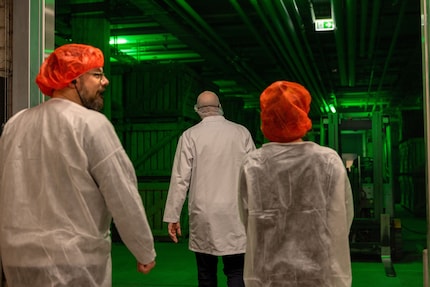
The light prevents the potatoes from turning green, while cool temperatures make sure they don’t sprout. What we’re seeing in front of us are potatoes planted by 300 farmers, most of them in Switzerland. Little labels with NFC chips attached to the crates tell us which farm delivered them. This is important information, as at the very end of the production process, it’s printed on the packet for full transparency.
A mostly Swiss, natural product
«Potatoes are a natural product, and really quite tricky to cultivate. That makes our work challenging,» explains Paul Beck, Head of Production and Logistics. Apparently Zweifel would prefer 100 per cent of their potatoes to be Swiss – certainly a possible goal on a good year. If conditions are poor, however, the chips giant sometimes has to switch to potatoes from neighbouring countries. According to Paul, 90 per cent of the potatoes Zweifel uses originate in Switzerland. The ones in the crate in front of us, for instance, were grown in Schönenwerd. We grab a couple of them from the box. They’re almost spherical, and about the size of tennis balls. «Size and shape are extremely important – it’s what makes the chips close to uniform in the end,» says Paul, gently putting the potato back. Potato composition is crucial too: «If the sugar content of the potatoes is too high, the chips will be too brown.»
We walk deeper into the cellar with the green light. The roar of machinery gets louder. Fortunately, we’ve been given a pair of headphones as well as a protective hood and coat. Production Manager Paul’s voice is piped directly into our ears via headset. The noise around us is coming from the washing machine, a water bath which separates rotten potatoes from larger foreign objects such as stones. Rotten potatoes float to the top, while stones and clumps of dirt fall out of the bottom. But stones aren’t the only things found among the detritus. One time, a hand grenade turned up. Another time, a dead slow worm.
From potato to chip in 30 minutes
After cleaning, a drum peels the potatoes with centrifugal force. There’s a kind of sandpaper on the outer edge that makes short work of their tough skins. Zweifel employees keep an eye on the process. «Even though a lot of what we do here is automated, our team constantly have to monitor things and make adjustments,» says Paul. If the machine peels away too much of the potato itself, money is lost.
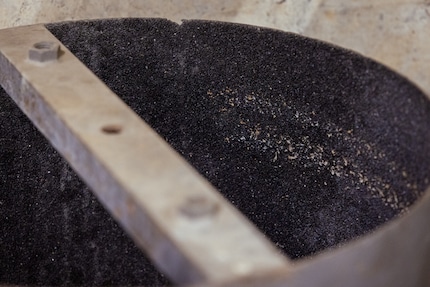
When this part’s finished, the potatoes are transported into the chip production area via a network of pipes. Unlike the green of the storage area, this room is brightly lit, and the earthy smell gives way to the aroma of chip fat and spices. The spaces between the machines are narrow and the floor’s wet and slippery, so we hold on to the handrails. «From this stage onwards, everything moves quickly,» Paul explains. «It’s highly likely that the potatoes we just saw will overtake us.»
It takes half an hour for a potato to go from being washed to becoming a bag of chips. First, a drum equipped with a knife cuts the potatoes into slices. Centrifugal forces are used here too. The blades on the cutting machine go blunt within two hours, at which point an employee has to replace them. Several of these cutting stations are in operation to make sure that production doesn’t come to a standstill. The sliced potatoes are then given another water bath before they disappear into the deep fryer.
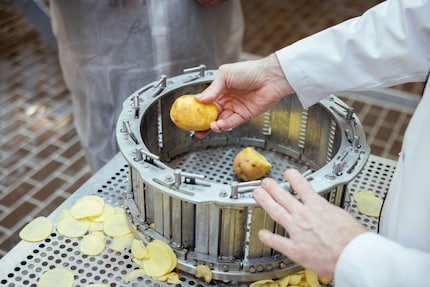
No oil changes necessary
The deep fryer boasts impressive specs. It’s more than eleven metres long, holds 6,000 litres of oil and consumes 500 litres of that oil per hour. Since the machine runs continuously, the fat never needs to be changed. Instead, it goes into the deep-fried chips. «This is a lovely batch,» Paul says, expertly inspecting the fresh chips on the conveyor belt. Each batch has its own set of characteristics. Every time a new batch comes to the fore, an employee has to slightly adjust the oil temperature to avoid the chips from coming out too brown or not fully fried. He scoops up some freshly baked potatoes from the conveyor belt. We bite into the still warm, unseasoned chips. It’s astounding how good fresh potato chips taste even without any salt or seasoning. In fact, it’d be a pretty great idea for a product.
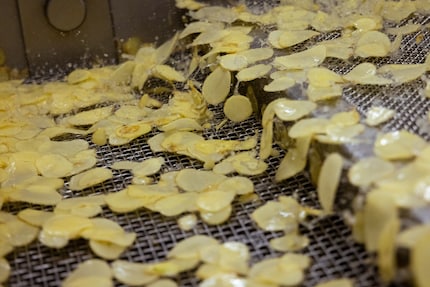
Scene change: we’re standing in the office of Bettina Hasler, Head of Product Development. Having said that, it’s probably more of a laboratory than an office. A cupboard with a glass door contains dozens of cans, neatly labelled with different flavours. This is where unusual chip varieties such as cervelat or kebab are created. Although Hasler’s team has more than 130 ideas in development, only about a dozen will ultimately be made into fully fledged flavours. It’s literally a taste-as-you-go situation. When the team develops a new flavour, 150 employees try it. If it passes the taste test, 200 customers known as «Friendz» are given sample packs to try and rate. It’s only once this is done that new flavours go into production, often just as limited editions, such as World Cup specials. Some past experiments, however, didn’t work out. «Cheese works really well as a flavour in other countries, including the US. In Switzerland, people aren’t particularly fond of it,» says Bettina diplomatically. There have been some complete flops too. «Our salmon-flavoured chips never made it out of this lab.»
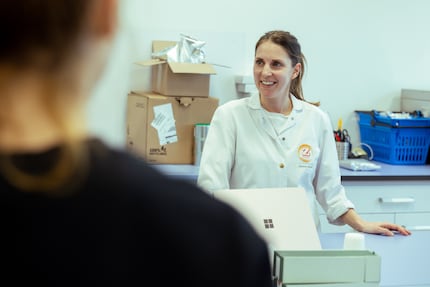
Back on the factory floor, we get to see advanced technology for the first time. A camera determines which chips are too brown, too green or otherwise subpar. The chips fly off the conveyor belt, going tumbling over an edge as they do so. From above, a jet of air blows the chips registered by the camera as faulty downwards, while the good chips make the leap over the abyss.
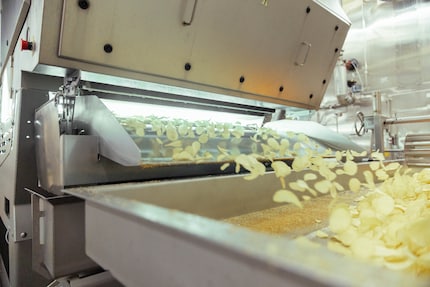
All this happens at an impressive speed and with incredible precision. «This must’ve made for monotonous, assembly-line style work in the past,» Paul says. The unseasoned chips end up forming a huge mountain, waiting for their flavouring. «The pile can’t get too high. If it does, we have to stop production. However, it can’t be too small either. Otherwise we’d have to stop the machinery further along the process,» Paul says. It’s only now that a decision is made regarding which flavouring will be added to the chips. The ones we’re looking at are mixed with Paprika seasoning in a large drum.

Zweifel distributes its chips across Switzerland
Once the seasoning’s done, it’s just a matter of divvying up the chips into bags. The process couldn’t be further removed from a kitchen scale-style weigh-in. A machine automatically portions the chips into twelve containers fitted with precision scales. Although these twelve portions appear to be the same size at first glance, weight differences of course emerge. Under one flap, you might find some slightly larger chips, weighing 35 grammes. Under the other, there might be slightly fewer, making a 29-gramme portion. At this point, a computer calculates which flaps it has to open to ensure exactly 175 grammes of chips end up in each pack.
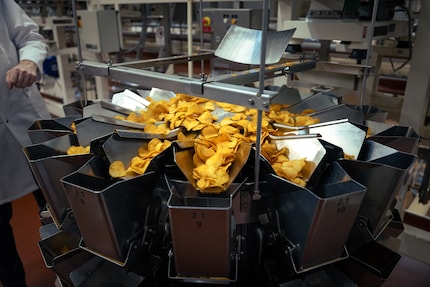
Again, this is done within seconds. Before we know it, the bulging bags of chips are already packed into orange boxes, which a robot then stacks on a pallet. «We have twelve distribution centres and 90 trucks for distributing potato chips and snacks throughout Switzerland,» Paul says. Sophisticated logistics is the key to Zweifel’s freshness guarantee. Needless to say, the chips can’t stay in storage for long.
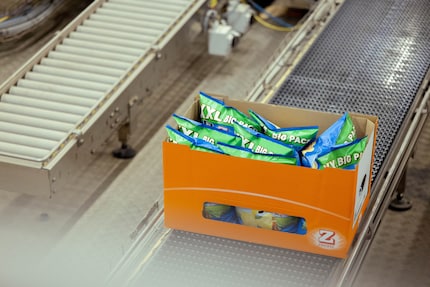
To round things off, we visit Zweifel’s in-house exhibition on the history of the company, where we get to taste our way through the product range. If the afternoon started out like a horror movie, it now has more of a Charlie and the Chocolate Factory vibe. Although you don’t need a golden ticket to visit the Zweifel factory for free, you do need patience. Guided tours of the facility are booked out months in advance.

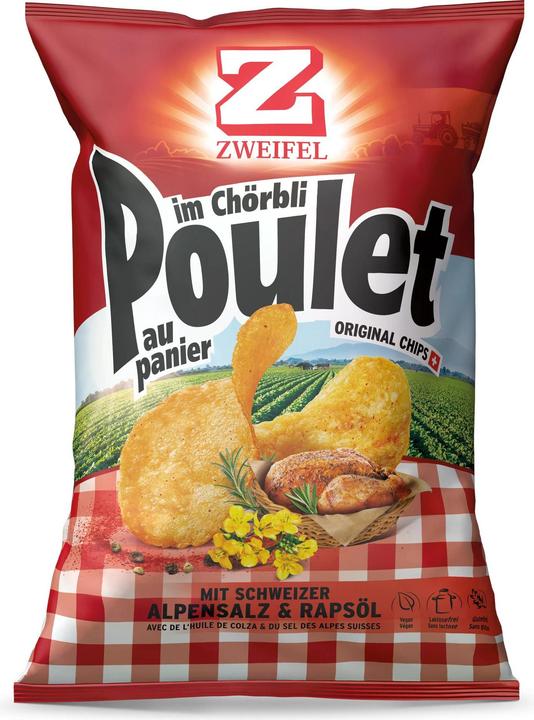
Zweifel Chicken in the Chörbli
175 g

Zweifel Chips Original Salt & Vinegar Spar
175 g
My podcast co-host Judith and I chatted about the visit to Zweifel in episode 50 of our Swiss-German culinary podcast «Uftischt».
When I flew the family nest over 15 years ago, I suddenly had to cook for myself. But it wasn’t long until this necessity became a virtue. Today, rattling those pots and pans is a fundamental part of my life. I’m a true foodie and devour everything from junk food to star-awarded cuisine. Literally. I eat way too fast.
Interesting facts about products, behind-the-scenes looks at manufacturers and deep-dives on interesting people.
Show all

